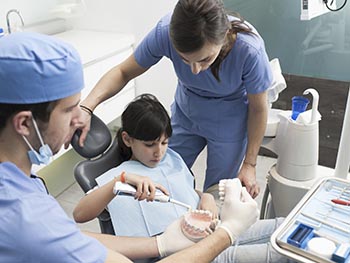It may seem logical that taking children to the dentist for regular preventive check-ups will lead to fewer pricy restorative procedures like filling a cavity. But new findings from the University of Alabama at Birmingham (UAB) published online in Pediatrics show the opposite.
 According to the American Academy of Pediatric Dentistry, it is recommended that children see a pediatric dentist as soon as their first tooth appears in order to prevent dental problems. Study lead author Bisakha Sen, Ph.D., said earlier research actually does not show that these visits lead to less costly dental issues in kids.
According to the American Academy of Pediatric Dentistry, it is recommended that children see a pediatric dentist as soon as their first tooth appears in order to prevent dental problems. Study lead author Bisakha Sen, Ph.D., said earlier research actually does not show that these visits lead to less costly dental issues in kids.
“It was shocking to us to find that previous data was misinterpreted, and there was actually more expensive restorative procedures among kids with more preventive dental visits, because this is counterintuitive,” Sen, associate professor in the Department of Healthcare Organization & Policy, explained.
“The problem is that these prior studies were limited by selection bias because children are not randomly taken to get preventive dental services,” Sen said. “It may be overly cautious or concerned parents, or children with a family history of dental problems who get these visits, then also use more restorative care.”
To investigate further without bias, Sen’s team used data collected from 1998-2010 by Alabama’s Children’s Health Insurance Program (CHIP), ALL Kids, a low-cost, comprehensive healthcare coverage program for children under age 19; benefits of ALL Kids include regular dental care.
Children who were continuously enrolled in CHIP for at least 3 years were included. Children who used non-preventive dental services the first year were not included because there was no information about their prior preventive dental service use. A total of 14,972 kids under the age of 8, and 21,833 ages 8 and older, were included.
Using a technique called individual fixed effects, the team was able to use each child as their own control, and then compare what happens to child X in a year when they do not get preventive visits, to a year when they do get preventive visits.
“Simpler techniques gave us the same findings of earlier work, but this more advanced technique we used was an effective, though not fool-proof, way of controlling for the selection problem of past literature,” Sen said.
What they found was that more preventive visits were associated with fewer subsequent restorative services for the same child for both age groups, even though the cost savings for CHIP do not appear to sufficiently cover the cost of the preventive services.
For example, the researchers find that when children had one preventive visit, their subsequent non-preventive costs went down by an average of $25.67. However, this savings of $25.67 was not enough to offset what CHIP paid for the preventive visit. So when the costs of preventive visits and non-preventive visits were added together, overall CHIP spending was actually $90.94 more.
Despite the figures, the researchers caution against interpreting findings only with dollar figures in mind.
“Preventive visits may not just reduce non-preventive costs, but may also reduce pain and discomfort suffered by the child due to oral health problems,” Sen said.